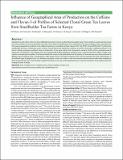| dc.contributor.author | Mose, M.T. | |
| dc.contributor.author | Ochanda, S.O, | |
| dc.contributor.author | Moseti, K.O. | |
| dc.contributor.author | Wanyoko, J.K. | |
| dc.contributor.author | Owuor, P.O. | |
| dc.contributor.author | Kinyua, J.K. | |
| dc.contributor.author | Kariuki, D. | |
| dc.contributor.author | Magiri, E.N. | |
| dc.contributor.author | Obanda, M.A. | |
| dc.date.accessioned | 2020-03-12T20:37:09Z | |
| dc.date.available | 2020-03-12T20:37:09Z | |
| dc.date.issued | 2019 | |
| dc.identifier.citation | Mose MT, Ochanda SO, Moseti KO, Wanyoko JK, Owuor PO, Kinyua JK 1, Kariuki D, Magiri EN, Obanda MA. Influence of Geographical Area of Production on the Caffeine and Flavan-3-ol Profiles of Selected Clonal Green Tea Leaves from Smallholder Tea Farms in Kenya. International Journal of Tea Science 2019;14(1):44-48 | en_US |
| dc.identifier.issn | DOI: 10.20425/ijts1416 | |
| dc.identifier.uri | https://repository.maseno.ac.ke/handle/123456789/1487 | |
| dc.description.abstract | Despite the use of similar cultivars in the smallholder tea sector in Kenya, resultant black tea quality varies. These variations could in part be arising from the formation of varying quantities and ratios of the black tea quality precursor compounds with agro-ecological zones of production. This study evaluated the variations in the caffeine and flavon-3-ol profiles of three cultivars (SFS 150, TRFK 31/8 and TRFK 303/577) of tea from smallholder tea farms in three agro-zones in Kenya. Overall, there were significant variations (p ≤0.05) in the levels of caffeine and flavan-3-ols due to cultivars and agro-ecological zones of production. In the same cultivar, the components varied (p ≤0.05) with an ecological area of
production. The patterns in the changes were not systematically leading significant ecological zone x cultivar interactions effects in gallic acid, catechin, and epicatechin gallate. This demonstrated that it may not be predictable how the quality of clonal tea may vary when produced in different agro-ecological zone. Consequently, a high-quality clone in one agro-ecological zone may not replicate the same characteristics in the different agro-ecological zone. It is, therefore, necessary to test new clones in new environments before they are extensively exploited in these environments. The current findings suggest that flavon-3-ols may not be potential factors in the discrimination of tea quality within the
ecological zones of Kenya. | en_US |
| dc.description.sponsorship | National Commission for Science, Technology, and
Innovation (NACOSTI), Kenya | en_US |
| dc.language.iso | en | en_US |
| dc.publisher | International Society of Tea Science | en_US |
| dc.subject | Agro-ecological zones, Camellia sinensis, Clonal variations, Flavan-3-ols | en_US |
| dc.title | Influence of Geographical Area of Production on the Caffeine and Flavan-3-ol Profiles of Selected Clonal Green Tea Leaves from Smallholder Tea Farms in Kenya | en_US |
| dc.type | Article | en_US |

